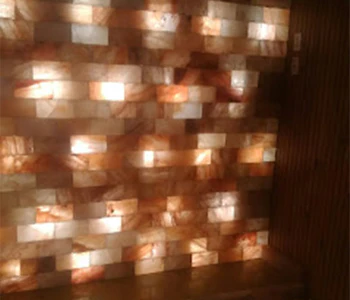
Salt bricks have been a popular building material for thousands of years, used for both their durability and aesthetic appeal. They have long been appreciated for their natural beauty with the recent advancements in building materials. These techniques have allowed for the creation of unique and innovative designs by combining them with other materials.
The accent of Feature Wall
One popular way to combine salt bricks with other materials is by using them as an accent or feature wall. For example, these bricks can be combined with glass, metal, or stone to create a stunning contrast between the organic and inorganic materials. This can result in an eye-catching design that showcases the natural beauty of the bricks while also highlighting the sleek and modern elements of the other materials.
Incorporate them to Furniture
Another way to incorporate salt bricks into a design is by using them as a decorative element. This can be done by incorporating these bricks into furniture, such as coffee tables or bookshelves, or by using them as a border around a garden or patio. The use of these bricks in the above mentioned applications not only adds to the overall aesthetic of the space, but it also provides a durable and long-lasting material that can withstand the elements.
Create Unique and Functional Designs
In addition to their use as an accent or decorative element, salt bricks can also be combined with other materials to create unique and functional designs. For example, these bricks can be used to build fireplaces, ovens, and grills that not only provide heat and cooking capabilities, but also add to the overall aesthetic of the space.
Greater Creativity and Customization
One of the key benefits of combining salt bricks with other materials is that it allows for greater creativity and customization in the design process. By combining different materials, designers and builders can create unique and one-of-a-kind designs that reflect the personality and style of the space and its inhabitants.
Proper Planning and Execution Required
It is important to note that the combination of salt bricks with other materials does require proper planning and execution to ensure that the design is both functional and aesthetically pleasing. It is recommended that designers and builders work with a professional who has experience in combining materials to ensure that the end result is of the highest quality.
Building Industry
To combine these bricks with other materials is a growing trend in the design and building industry. By incorporating these bricks into the design, designers and builders can create unique and innovative designs that showcase the natural beauty of this ancient building material while also incorporating the sleek and modern elements of other materials. With proper planning and execution, the combination of these natural bricks with other materials can result in stunning and functional designs that will stand the test of time.
Salt Bricks vs. Natural Build Materials
Well these bricks have become an increasingly popular alternative to traditional building materials, and it is easy to see why. They have a number of advantages over other natural building materials, including durability, affordability, and sustainability. In this article, we will compare these bricks with other natural building materials such as clay bricks, stone, and adobe.
Durability
Salt bricks are made from compressed salt crystals and are extremely durable. They can withstand extreme weather conditions and are resistant to moisture, fire, and insects. On the other hand, clay bricks can crack and crumble over time, and stone can become chipped and worn down by the elements. Adobe is also susceptible to moisture damage and can be subject to erosion and collapse.
Affordability
These bricks are cheaper than many other natural building materials. They are also easy to obtain, as salt is readily available in most parts of the world. In comparison, clay bricks, stone, and adobe can be much more expensive and difficult to source.
Sustainability
These are sustainable building material because they are made from a renewable resource (salt) and can be recycled at the end of their life. Clay bricks and stone require a significant amount of energy to produce, and adobe can be unsustainable if the soil used to make it is not properly managed.
Appearance
Having unique and attractive appearance can add character to any building. They can be painted or left in their natural state to create a variety of different effects. Clay bricks, stone, and adobe can also add visual appeal to a building.
More Durable and Eco-friendly
These are very innovative building materials made of compressed salt crystals. They are not only durable and cost-effective but also environmentally friendly. In this article, we will explore the positive impact of the bricks on the environment and sustainability.
Energy-Efficient
Salt bricks have excellent insulation properties, making them energy-efficient. The walls made from these bricks help to regulate indoor temperature, reducing the need for heating or cooling systems. This leads to reduced energy consumption, lower energy bills, and a reduced carbon footprint.
Renewable Resource
Salt is a renewable resource, making it an environmentally sustainable building material. Unlike other building materials like concrete or steel, the production of salt bricks does not deplete finite resources or contribute to the depletion of natural habitats.
Long-Lasting
Salt bricks have a long lifespan, making them a sustainable choice for construction. They are resistant to moisture, fire, and pests and they do not rot or decay over time. This means that they require less maintenance and replacement, reducing waste and improving sustainability.
Non-Toxic
These are non-toxic and safe for the environment. They do not contain any harmful chemicals or substances that can harm the environment or human health.
Reusable and Recyclable
At the end of their lifespan, these bricks can be crushed and reused as salt for de-icing roads or other applications. This makes them a recyclable and sustainable building material, reducing the need for new materials and reducing waste.
Bottom-line:
In conclusion, salt bricks offer numerous environmental and sustainability benefits. From energy-efficiency to renewable resources, non-toxicity, and long-lasting durability, salt bricks are a responsible and sustainable choice for construction. Whether you are building a new home or renovating an existing one, consider these bricks for a positive impact on the environment and sustainability. They offer many advantages over other natural building materials, including durability, affordability, sustainability, and appearance. If you are considering building with a natural material, these bricks are definitely worth considering.
Read More : The role of salt bricks in preserving historical buildings and monument


